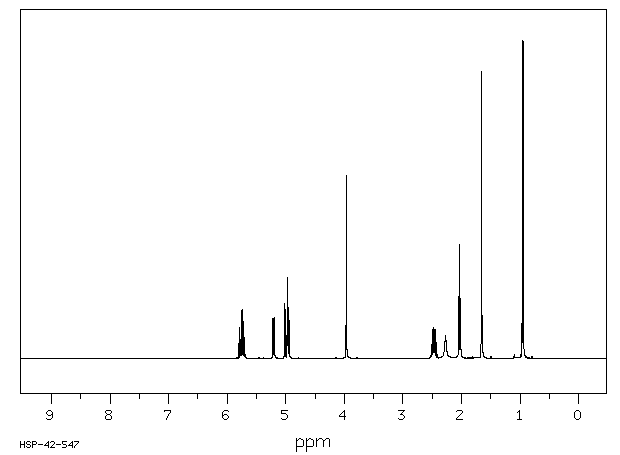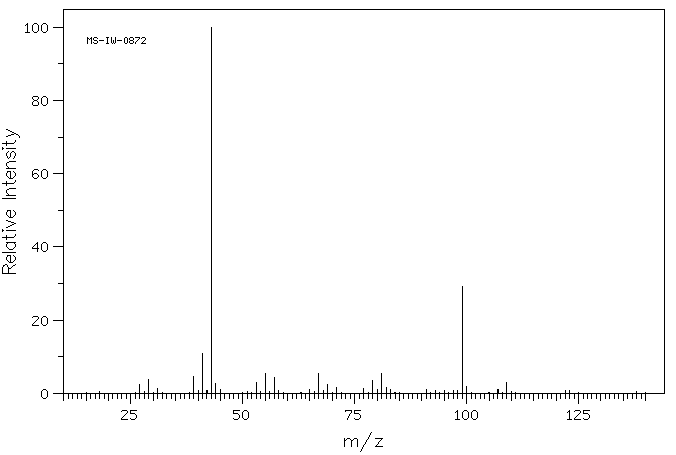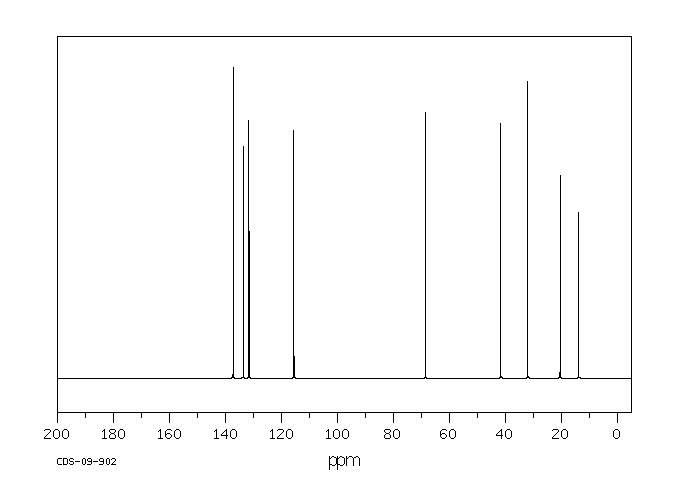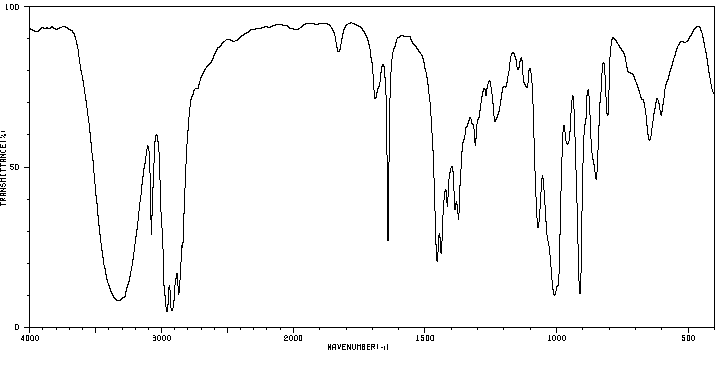2,4-dimethyl-2,6-heptandienol | 80192-56-9
中文名称
——
中文别名
——
英文名称
2,4-dimethyl-2,6-heptandienol
英文别名
2,4-dimethyl-2,6-heptadien-1-ol;2,4-dimethyl-2,6-heptadienol;2,4-Dimethylhepta-2,6-dien-1-ol;(2E)-2,4-dimethylhepta-2,6-dien-1-ol
CAS
80192-56-9
化学式
C9H16O
mdl
——
分子量
140.225
InChiKey
YBRHBMHQQIEOOL-RMKNXTFCSA-N
BEILSTEIN
——
EINECS
——
-
物化性质
-
计算性质
-
ADMET
-
安全信息
-
SDS
-
制备方法与用途
-
上下游信息
-
文献信息
-
表征谱图
-
同类化合物
-
相关功能分类
-
相关结构分类
物化性质
-
沸点:86 °C10 mm Hg(lit.)
-
密度:0.865 g/mL at 25 °C(lit.)
-
闪点:173 °F
-
LogP:2.551 (est)
-
稳定性/保质期:
遵照规定使用和储存,则不会分解。
计算性质
-
辛醇/水分配系数(LogP):2.4
-
重原子数:10
-
可旋转键数:4
-
环数:0.0
-
sp3杂化的碳原子比例:0.56
-
拓扑面积:20.2
-
氢给体数:1
-
氢受体数:1
安全信息
-
危险品标志:Xi
SDS
| Name: | 2 4-Dimethyl-2 6-Heptadien-1-ol 99% Material Safety Data Sheet |
| Synonym: | None known |
| CAS: | 80192-56-9 |
Synonym:None known
Section 2 - COMPOSITION, INFORMATION ON INGREDIENTS
| CAS# | Chemical Name | content | EINECS# |
| 80192-56-9 | 2,4-Dimethyl-2,6-Heptadien-1-ol | 99 | 279-418-2 |
Risk Phrases: None Listed.
Section 3 - HAZARDS IDENTIFICATION
EMERGENCY OVERVIEW
Not available.
Potential Health Effects
Eye:
May cause eye irritation. May cause chemical conjunctivitis and corneal damage.
Skin:
May cause irritation and dermatitis. May cause cyanosis of the extremities.
Ingestion:
May cause gastrointestinal irritation with nausea, vomiting and diarrhea. The toxicological properties of this substance have not been fully investigated.
Inhalation:
May cause respiratory tract irritation. The toxicological properties of this substance have not been fully investigated. Aspiration may lead to pulmonary edema. Inhalation at high concentrations may cause CNS depression and asphixiation.
Chronic:
No information found.
Section 4 - FIRST AID MEASURES
Eyes: Flush eyes with plenty of water for at least 15 minutes, occasionally lifting the upper and lower eyelids. Get medical aid.
Skin:
Get medical aid. Flush skin with plenty of water for at least 15 minutes while removing contaminated clothing and shoes. Wash clothing before reuse.
Ingestion:
Never give anything by mouth to an unconscious person. Get medical aid. Do NOT induce vomiting. If conscious and alert, rinse mouth and drink 2-4 cupfuls of milk or water.
Inhalation:
Remove from exposure and move to fresh air immediately. If not breathing, give artificial respiration. If breathing is difficult, give oxygen. Get medical aid. Do NOT use mouth-to-mouth resuscitation.
Notes to Physician:
Section 5 - FIRE FIGHTING MEASURES
General Information:
As in any fire, wear a self-contained breathing apparatus in pressure-demand, MSHA/NIOSH (approved or equivalent), and full protective gear. During a fire, irritating and highly toxic gases may be generated by thermal decomposition or combustion. Use water spray to keep fire-exposed containers cool. Water may be ineffective.
Material is lighter than water and a fire may be spread by the use of water. Combustible liquid. Vapors may be heavier than air. They can spread along the ground and collect in low or confined areas.
Containers may explode when heated.
Extinguishing Media:
Use water spray to cool fire-exposed containers. Use water spray, dry chemical, carbon dioxide, or appropriate foam.
Section 6 - ACCIDENTAL RELEASE MEASURES
General Information: Use proper personal protective equipment as indicated in Section 8.
Spills/Leaks:
Absorb spill with inert material (e.g. vermiculite, sand or earth), then place in suitable container. Avoid runoff into storm sewers and ditches which lead to waterways. Clean up spills immediately, observing precautions in the Protective Equipment section. Remove all sources of ignition. Use a spark-proof tool. Provide ventilation.
Section 7 - HANDLING and STORAGE
Handling:
Wash thoroughly after handling. Remove contaminated clothing and wash before reuse. Use with adequate ventilation. Avoid contact with eyes, skin, and clothing. Empty containers retain product residue, (liquid and/or vapor), and can be dangerous. Keep container tightly closed. Keep away from heat, sparks and flame. Avoid ingestion and inhalation. Do not pressurize, cut, weld, braze, solder, drill, grind, or expose empty containers to heat, sparks or open flames.
Storage:
Keep away from heat, sparks, and flame. Keep away from sources of ignition. Store in a tightly closed container. Store in a cool, dry, well-ventilated area away from incompatible substances.
Section 8 - EXPOSURE CONTROLS, PERSONAL PROTECTION
Engineering Controls:
Facilities storing or utilizing this material should be equipped with an eyewash facility and a safety shower. Use adequate ventilation to keep airborne concentrations low.
Exposure Limits CAS# 80192-56-9: Personal Protective Equipment Eyes: Wear appropriate protective eyeglasses or chemical safety goggles as described by OSHA's eye and face protection regulations in 29 CFR 1910.133 or European Standard EN166.
Skin:
Wear appropriate protective gloves to prevent skin exposure.
Clothing:
Wear appropriate protective clothing to prevent skin exposure.
Respirators:
Follow the OSHA respirator regulations found in 29 CFR 1910.134 or European Standard EN 149. Use a NIOSH/MSHA or European Standard EN 149 approved respirator if exposure limits are exceeded or if irritation or other symptoms are experienced.
Section 9 - PHYSICAL AND CHEMICAL PROPERTIES
Physical State: Liquid
Color: slight clear yellow
Odor: none reported
pH: Not available.
Vapor Pressure: Not available.
Viscosity: Not available.
Boiling Point: 86 deg C @ 10.00mm Hg
Freezing/Melting Point: Not available.
Autoignition Temperature: Not available.
Flash Point: 78 deg C ( 172.40 deg F)
Explosion Limits, lower: Not available.
Explosion Limits, upper: Not available.
Decomposition Temperature:
Solubility in water:
Specific Gravity/Density: 0.865
Molecular Formula: C9H16O
Molecular Weight: 140.22
Section 10 - STABILITY AND REACTIVITY
Chemical Stability:
Stable under normal temperatures and pressures.
Conditions to Avoid:
Incompatible materials, ignition sources, excess heat, strong oxidants.
Incompatibilities with Other Materials:
Acid anhydrides, acid chlorides, strong acids, strong oxidizing agents, strong reducing agents.
Hazardous Decomposition Products:
Carbon monoxide, irritating and toxic fumes and gases, carbon dioxide.
Hazardous Polymerization: Has not been reported
Section 11 - TOXICOLOGICAL INFORMATION
RTECS#:
CAS# 80192-56-9 unlisted.
LD50/LC50:
Not available.
Carcinogenicity:
2,4-Dimethyl-2,6-Heptadien-1-ol - Not listed by ACGIH, IARC, or NTP.
Section 12 - ECOLOGICAL INFORMATION
Section 13 - DISPOSAL CONSIDERATIONS
Dispose of in a manner consistent with federal, state, and local regulations.
Section 14 - TRANSPORT INFORMATION
IATA
Not regulated as a hazardous material.
IMO
Not regulated as a hazardous material.
RID/ADR
Not regulated as a hazardous material.
Section 15 - REGULATORY INFORMATION
European/International Regulations
European Labeling in Accordance with EC Directives
Hazard Symbols: Not available.
Risk Phrases:
Safety Phrases:
S 24/25 Avoid contact with skin and eyes.
S 28A After contact with skin, wash immediately with
plenty of water.
S 37 Wear suitable gloves.
S 45 In case of accident or if you feel unwell, seek
medical advice immediately (show the label where
possible).
WGK (Water Danger/Protection)
CAS# 80192-56-9: No information available.
Canada
None of the chemicals in this product are listed on the DSL/NDSL list.
CAS# 80192-56-9 is not listed on Canada's Ingredient Disclosure List.
US FEDERAL
TSCA
CAS# 80192-56-9 is not listed on the TSCA inventory.
It is for research and development use only.
SECTION 16 - ADDITIONAL INFORMATION
N/A
反应信息
-
作为反应物:描述:2,4-dimethyl-2,6-heptandienol 在 2-氯-1-甲基吡啶碘化物 、 三乙胺 作用下, 以 四氢呋喃 为溶剂, 反应 3.0h, 生成 3-dimethylamino-2-isocyano-acrylic acid 2,4-dimethyl-hepta-2,6-dienyl ester参考文献:名称:Short and Diverse Route Toward Complex Natural Product-Like Macrocycles摘要:[GRAPHICS]A general strategy toward macrocyclic compounds using multicomponent reaction (MCR) chemistry, e.g., Passerini and Ugi variants, and ring-closing metathesis (RCM) is introduced. The corresponding bifunctional isocyanides carboxylic acids bearing a terminal olefin are easy to prepare from the corresponding commercially available starting materials. Advantageously, this strategy allows fast access to a diverse conformational space of natural product-like macrocycles and could thus be of interest in the discovery of novel bioactive agents.DOI:10.1021/ol034077e
-
作为产物:描述:(E)-2,4-dimethylhepta-2,6-dienal 在 sodium tetrahydroborate 作用下, 以 甲醇 为溶剂, 生成 2,4-dimethyl-2,6-heptandienol参考文献:名称:吲哚硼酸酯中分子内烷基迁移过程在分子内环化中的合成应用:咔唑衍生物的新型结构摘要:吲哚硼酸酯中的分子内烷基迁移反应是通过分子内环化反应一锅构建咔唑而开发的,其中π-烯丙基铝配合物被成功地用作吲哚亲核体的受体。DOI:10.1016/s0040-4020(02)01293-0
文献信息
-
Process for preparing vinyl substituted beta-diketones申请人:Southard E. Glen公开号:US20060069288A1公开(公告)日:2006-03-30A process for preparing vinyl substituted beta-diketones includes reacting a halogen-containing beta-diketone with an olefin in a reaction zone under Heck coupling reaction conditions in the presence of a catalyst, a base, and an organic phosphine to provide a vinyl substituted beta-diketone product.
-
[EN] PROCESS FOR PRODUCING TETRABROMOBENZOATE ESTERS<br/>[FR] PROCEDE DE PRODUCTION D'ESTERS DE TETRABROMOBENZOATE申请人:PABU SERVICES INC公开号:WO2005016863A1公开(公告)日:2005-02-24A method for preparing tetrabromobenzoate ester from a tetrabromophthalic anhydride including the steps of reacting the tetrabromophthalic anhydride with a catalyst and an alcohol at a temperature that favors partial esterification over complete esterification of the tetrabromophthalic anhydride to form a tetrabromophthalate half-ester reaction mixture; and feeding the half-ester reaction mixture to at least one reactor having and maintaining a temperature that favors decarboxylation over esterification to produce a tetrabromobenzoate ester-containing product. The temperature favoring partial esterification of the tetrabromophthalic anhydride is between about 70°C and 130°C. The temperature favoring decarboxylation over esterification is between about 190°C and 205°C. The tetrabromobenzoate ester-containing product comprises at least about 85% tetrabromobensoate ester. The at least one reactor may include two or more reactors connected to one another in series.
-
Process for producing tetrabromobenzoate esters申请人:Bartley W. David公开号:US20050027139A1公开(公告)日:2005-02-03A method for preparing tetrabromobenzoate ester from a tetrabromophthalic anhydride including the steps of reacting the tetrabromophthalic anhydride with a catalyst and an alcohol at a temperature that favors partial esterification over complete esterification of the tetrabromophthalic anhydride to form a tetrabromophthalate half-ester reaction mixture; and feeding the half-ester reaction mixture to at least one reactor having and maintaining a temperature that favors decarboxylation over esterification to produce a tetrabromobenzoate ester-containing product. The temperature favoring partial esterification of the tetrabromophthalic anhydride is between about 70° C. and 130° C. The temperature favoring decarboxylation over esterification is between about 190° C. and 205° C. The tetrabromobenzoate ester-containing product comprises at least about 85% tetrabromobenzoate ester. The at least one reactor may include two or more reactors connected to one another in series.
-
2,4-Dialkyl-2,6-heptadienal derivatives, a process for their申请人:Consortium fur Elektrochemische Industrie GmbH公开号:US04380675A1公开(公告)日:1983-04-19Compounds of the formula ##STR1## wherein R.sub.1 and R.sub.2 are equal or different aliphatic radicals, if desired, branched, and R.sub.3 stands for H or CH.sub.3. The invention also relates to a process for making these compounds and their use as fragrant and flavoring products.
-
[EN] MOLECULARLY IMPRINTED POLYMERS FOR EXTRACTION OF CANNABINOIDS AND USES THEREOF<br/>[FR] POLYMÈRES À EMPREINTE MOLÉCULAIRE POUR L'EXTRACTION DE CANNABINOÏDES ET UTILISATIONS ASSOCIÉES申请人:6TH WAVE INNOVATIONS CORP公开号:WO2020186077A1公开(公告)日:2020-09-17The present disclosure relates to molecularly imprinted polymers that target cannabinoid(s), including THC and CBD, as well as methods of making molecularly imprinted polymers that target cannabinoid(s), including THC and CBD and uses thereof.
表征谱图
-
氢谱1HNMR
-
质谱MS
-
碳谱13CNMR
-
红外IR
-
拉曼Raman
-
峰位数据
-
峰位匹配
-
表征信息
同类化合物
(±)17,18-二HETE
(±)-辛酰肉碱氯化物
(Z)-5-辛烯甲酯
(Z)-4-辛烯酸
(R)-甲羟戊酸锂盐
(R)-普鲁前列素,游离酸
(R,R)-半乳糖苷
(E)-4-庚烯酸
(E)-4-壬烯酸
(E)-4-十一烯酸
(9Z,12E)-十八烷二烯酸甲酯
(6E)-8-甲基--6-壬烯酸甲基酯-d3
(3R,6S)-rel-8-[2-(3-呋喃基)-1,3-二氧戊环-2-基]-3-羟基-2,6-二甲基-4-辛酮
龙胆二糖
黑曲霉二糖
黄质霉素
麦芽酮糖一水合物
麦芽糖醇
麦芽糖酸
麦芽糖基蔗糖
麦芽糖一水合物
麦芽糖
鳄梨油酸乙酯
鲸蜡醇蓖麻油酸酯
鲸蜡醇油酸酯
鲸蜡硬脂醇硬脂酸酯
鲸蜡烯酸脂
鲸蜡基花生醇
鲫鱼酸
鲁比前列素
鲁比前列素
高级烷基C16-18-醇
高甲羟戊酸
高效氯氰菊酯
高-gamma-亚油酸
马来酸烯丙酯
马来酸氢异丙酯
马来酸氢异丁酯
马来酸氢丙酯
马来酸氢1-[2-(2-羟基乙氧基)乙基]酯
马来酸单乙酯
马来酸单丁酯
马来酸二辛酯
马来酸二癸酯
马来酸二甲酯
马来酸二烯丙酯
马来酸二正丙酯
马来酸二戊基酯
马来酸二异壬酯
马来酸二异丙酯










